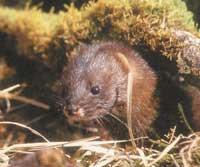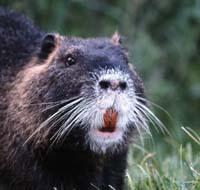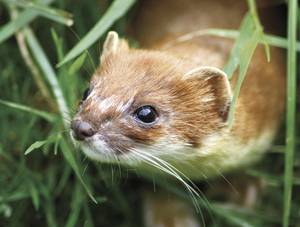European mink returns to Salburua
2010/07/01 Aulestiarte Lete, Izaro - Elhuyar Zientziaren Komunikazioa Iturria: Elhuyar aldizkaria
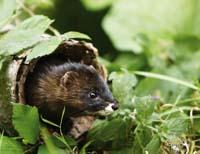
Habitat loss, contaminated water, the disease known as aleutiana, and vehicular traffic are typical problems of the European mink, but it is also more serious. It can be said that the biggest enemy is the current invading American mink. "We must take into account the destruction of habitat and human influence, but the biggest problem for the situation of the European mink to be so serious are the exotic species, in this case the American mink", summarizes Haizea Agirre, field technician who has worked on the reintroduction program of Salburua (Vitoria).
The American ( Mustela vison) has spread almost all over Europe in recent decades, especially by the leather industry, and has always been a rival of the European mink. According to Agirre, it is easy to understand: "Both species are territorial and cannot coexist in the same area; one of them is forced to abandon. The American is bigger, more aggressive and much more opportunistic, since it adapts more easily to new media and food. In addition, it has a higher playback rate. So the European is always losing."
Therefore, Agirre is clear that if the situation of the American mink is not controlled, efforts to strengthen the European mink are useless. Of the same opinion is Joseba Carreras, Head of the Department of Biodiversity of the Alava Provincial. In particular, since 2003 the control of the American species in Alava is carried out annually. "We had suspicions, but now we have found that for the first time the American mink directly attacks the European," he said. In particular, this year a large American mink has been considered responsible for the attacks against the European and has turned in its attempt to catch him. "In the end they have detected it, but it has cleaned many animals during that time."
The presence of the American mink in the Iberian Peninsula is really important. From Extremadura to Burgos, among others, it has "occupied". "For this reason," says Carreras-- "Burgos and Soria are working so that they do not go to the Ebro, where the largest European population is located. The truth is that in Alava, and in the center of the European mink area, there were Americans. And we didn't want that species to come to Navarre by Arakil and Ega, or to pass through the Zadorra to the Ebro. If it reached Navarre or the Ebro, the population of the peninsular European mink was over." In his opinion, the measures taken to "eradicate" the American are the most effective steps in favor of the European mink.
The carnivore that once existed throughout Europe is found only in Russia, Romania and France. "They are also located on the Hiiumaa island of Estonia (thanks to a similar program), but the best population is that of the upper part of the Ebro river, between Álava, La Rioja, Burgos and Navarra. Therefore, we also seek to reconnect the population of the Salburua area with that of the Ebro basin so that they do not remain isolated," said Haizea Agirre.
First phase 2007
Although its beginnings date back to the early 1990s, the Salburua European mink recovery project began in 2007. The Provincial Council requested the collaboration of the Ministry of the Environment to address the serious situation of the species. He gave the reintroduction program green light. This decision is only made in critical situations.
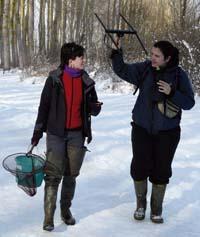
The Salburua is a privileged place for minks. Its proximity to wetlands and rivers and the abundance of dense bushes make this habitat a habitat of great interest. In addition, the environment is fenced and careful to protect yourself from unwanted human interventions. Once the site was selected, the Ministry of Spain (Fundación Biodiversidad), the Provincial Council and the Center for Environmental Studies of the City of Vitoria-Gasteiz began work. They are also supported by the European Mink Association.
In 2007 large cages were built and installed in the park, in which at the end of April 2008 two pregnant females were introduced from a specialized center of Pont de Suert (Lleida), in which grow European minks for repopulation projects that maintain genetic characteristics similar to wild minks.
Mink breeding takes about three months to mature and was fed during that time. But the cages faithfully imitate the animal's habitat and its relationship with human beings is very small, "so that food does not engage with man and when we release them it molds itself," says Agirre.
In August 2008, mothers and offspring were released (eight in total). The first few days the team gave them food just in case. And then radiotracking was used to track minks. To do this a small harmless emitter is placed to each animal. Project members have a receiver (hand and car antennas) that receives the mink signal. They walk, bike or car, sometimes day and night, and for five or six months the battery of the emitters is exhausted.
Each of these animals baptized with the toponyms of Álava, Burgos and La Rioja has its own unique frequency. This way, they know their location, movements and other data, including a death sensor. They also learned that one of the Salburua minks moved to the Arakil River in Navarre.
Eleven paths, one direction
The 2008 "soft release" was repeated last year with the release of 16 minks. But the so-called "hard liberation" has also been done for two years. In August they bring from Lleida a female after childbirth with their baby. For a week they stay in the cages of Salburua and then release them directly.
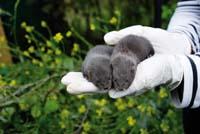
In 2008, six soft and two strong soles were made, while last year seven soft and nine hard. The survival rate for people released in the first year was 29% in the first three months and 44% in 2009 in the first four months. Most of the deaths were due to natural predators (foxes, birds of prey...), but last year they saw the "shadow" of the American mink after most cases.
Another system has been tested this year. Two brave females were released in May without passing through the cages (hard release). They also put two females in cages. The latter, however, will not release them. After delivery they will return directly to Lleida to continue the research.
"In short, all this is just a pilot project. We know similar experiences in Estonia and Germany and we are applying their techniques here in different ways to see if they are successful," explained Joseba Carreras.
It is too early to have all the conclusions of the results obtained so far in Salburua. But he believes they are on the right track in search of the best system to "save" the European mink. "If a single mink (especially a female) survives, it directly influences the population of the very serious species. It's not little," says Carreras. "The next step would be to make a general plan to reintroduce the mink throughout the peninsula by 2011. Therefore, we still have a year to do different tests."
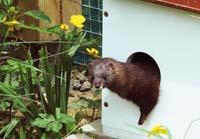

Gai honi buruzko eduki gehiago
Elhuyarrek garatutako teknologia



